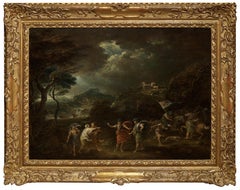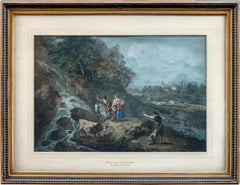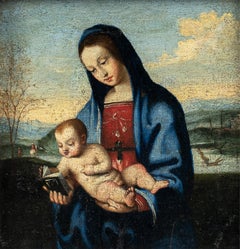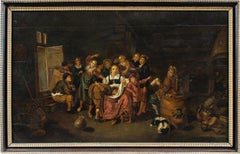Francesco Zuccarelli Paintings
to
2
Overall Width
to
Overall Height
to
2
2
1
2
2
1
1
2
1
1
1
1
3
783
707
704
700
1
1
2
Artist: Francesco Zuccarelli
Macbeth and the Three Witches a Painting on Panel by Francesco Zuccarelli
By Francesco Zuccarelli
Located in PARIS, FR
This painting, created during Zuccarelli's stay in England, represents the decisive moment when Macbeth, together with Banquo, meets the three witches who announce that he will be Ki...
Category
1760s Old Masters Francesco Zuccarelli Paintings
Materials
Oil, Wood Panel
Francesco Zuccarelli (Venetian master) - 18th century landscape painting
By Francesco Zuccarelli
Located in Varmo, IT
Francesco Zuccarelli (Pitigliano 1702 - Florence 1788) - River landscape with shepherds and herds.
31 x 46 cm without frame, 47.5 x 57 cm with frame.
Tempera on paper, in a gilded ...
Category
Mid-18th Century Rococo Francesco Zuccarelli Paintings
Materials
Tempera, Paper
Related Items
Raphael's workshop (Umbrian Renaissance) - 16th century figure painting - Virgin
Located in Varmo, IT
Umbrian painter (16th century) - Madonna and Child in a Landscape (Madonna Conestabile).
19 x 18 cm unframed, 34 x 33 cm with frame.
Oil on canvas mounted on panel, in a gilded woo...
Category
16th Century Old Masters Francesco Zuccarelli Paintings
Materials
Oil, Panel
$6,547
H 13.39 in W 13 in
Baroque Dutch painter - Late 18th century figure painting - Inn Interior - Panel
Located in Varmo, IT
Dutch painter (18th-19th century) - The spanking.
60 x 99 cm without frame, 67 x 106 cm with frame.
Antique oil painting on panel, without frame (not signed).
Condition report: Wo...
Category
Late 18th Century Old Masters Francesco Zuccarelli Paintings
Materials
Oil, Panel
$2,380 Sale Price
28% Off
H 26.38 in W 41.74 in
Shipping in Calm Waters, 18th Century Dutch Oil on Wood Panel, Man o War
Located in Cirencester, Gloucestershire
Shipping in Calm Waters
Dutch School, 18th century
oil painting on wood panel
panel: 10 x 12.75 inches
framed: 14 x 17 inches
condition: very good, minor evidenc...
Category
18th Century Old Masters Francesco Zuccarelli Paintings
Materials
Oil, Wood Panel
$3,019
H 14 in W 17 in D 1 in
Antique French Oil Classical Figures in a Romantic Woodland Landscape & Swans
Located in Cirencester, Gloucestershire
Riverside Gathering
French Rococo School, 19th century
signed indistinctly lower front corner
oil on canvas, framed
Framed: 26 x 34 inches
Canvas: 24 x 32 inches
Provenance: private ...
Category
19th Century Rococo Francesco Zuccarelli Paintings
Materials
Oil
Antique Roman painter - 18th century landscape painting - Wanderers - Italy
Located in Varmo, IT
Roman painter (18th century) - Landscape with Wayfarers.
43.5 x 34.5 cm unframed, 58.5 x 49.5 cm with frame.
Ancient oil painting on canvas, in a carved and gilded wooden frame (no...
Category
Early 18th Century Old Masters Francesco Zuccarelli Paintings
Materials
Canvas, Oil
$1,190 Sale Price
44% Off
H 23.04 in W 19.49 in
18th century English marine Battle scene between Dutch and British warships
By Francis Swaine
Located in Woodbury, CT
Attributed to Francis Swaine (British, 1725–1782)
Naval Engagement at Sea, 18th century
Oil on panel
In this evocative seascape, a cluster of ships—flags raised, cannons fired—conve...
Category
1760s Old Masters Francesco Zuccarelli Paintings
Materials
Oil, Wood Panel
Landscape in Falconara - Paint by Sirio Pellegrini - 1968
Located in Roma, IT
Oil and tempera on cardboard realized by Sirio Pellegrini in 1968.
Hand signed and dated.
It represents a seascape in Falconara Marittima.
A wooden frame realized by the Artist in...
Category
1960s Contemporary Francesco Zuccarelli Paintings
Materials
Oil, Tempera, Cardboard
$3,333
H 15.36 in W 19.1 in D 0.04 in
19th Century Roman Landscape oil on canvas with Giltwood Frame
Located in Rome, IT
Amaizing 19' century Roman landscape depicting a part of Villa Borghese with Trinità dei Monti.
With a finely carved gilt wood coeval frame.
Measurements with frame cm 65 x78 wit...
Category
19th Century Old Masters Francesco Zuccarelli Paintings
Materials
Oil
$5,357
H 25.6 in W 30.71 in D 1.97 in
17th century Flemish seascape - Stormy Sea with Merchant Vessels and dolphins
By Bonaventura Peeters the Elder
Located in Aartselaar, BE
Bonaventura Peeters the Elder (1614–1652) attr., Stormy Coastal Scene with Merchant Vessels, Galliot, and Dolphins
Framed by rugged cliffs and illuminated under a dark, swirling sk...
Category
17th Century Old Masters Francesco Zuccarelli Paintings
Materials
Oil, Panel
$7,738
H 16.15 in W 27.76 in
18th Century French Oil Artist Painting Nude Model Classical Garden Scene
Located in Cirencester, Gloucestershire
The Artist and his Model
French School, 18th century
oil on canvas, framed
Framed: 14 x 17 inches
Board: 11 x 14 inches
Provenance: private collection, France
Condition: very good co...
Category
18th Century Rococo Francesco Zuccarelli Paintings
Materials
Oil
Antique French Oil Classical Figures in a Romantic Woodland Landscape & Swans
Located in Cirencester, Gloucestershire
Riverside Gathering
French Rococo School, 19th century
signed lower front corner
oil on canvas, framed
Framed: 26 x 34 inches
Canvas: 24 x 32 inches
Provenance: private collection, F...
Category
19th Century Rococo Francesco Zuccarelli Paintings
Materials
Oil
Studio per -Aeroarmonie- Tempera 1933 cm. 62 x 49
By Osvaldo Peruzzi
Located in Torino, IT
Studio per l’opera Aeroarmonie esposto alla biennale di Venezia del 1934
Sul retro cartiglio :
Ufficio storico -Popolo d’Italaia-
Autentica prof. Duranti N° archivio 2272
Osvaldo Per...
Category
1930s Futurist Francesco Zuccarelli Paintings
Materials
Tempera, Cardboard
$41,666
H 27.17 in W 32.68 in D 3.15 in
Francesco Zuccarelli paintings for sale on 1stDibs.
Find a wide variety of authentic Francesco Zuccarelli paintings available for sale on 1stDibs. You can also browse by medium to find art by Francesco Zuccarelli in paint, oil paint, panel and more. Much of the original work by this artist or collective was created during the 18th century and is mostly associated with the Old Masters style. Not every interior allows for large Francesco Zuccarelli paintings, so small editions measuring 23 inches across are available. Customers who are interested in this artist might also find the work of Giulio Di Sotto, Pietro Colonna, and Antonio Savisio. Francesco Zuccarelli paintings prices can differ depending upon medium, time period and other attributes. On 1stDibs, the price for these items starts at $5,385 and tops out at $55,000, while the average work can sell for $30,192.



